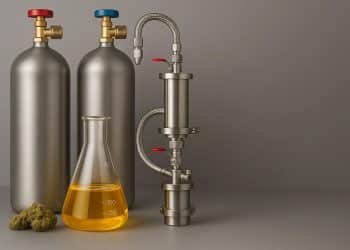Will the Cost Ever go Down?
Cannabis concentrates in their many forms are sweeping the marketplace. Their popularity is growing at such a pace that their market cap will soon outgrow that of virgin cannabis flower sales. As most people by now know, there are several methods of producing cannabis concentrates, the most popular among them being supercritical CO2 and hydrocarbon extractions. However, the difference in cost between one and the other is considerable.
A supercritical CO2 extraction system can range anywhere from $40-$500 thousand. And that doesn’t include any of the ancillary equipment necessary to produce refined cannabis concentrates. Many people believe that this price point is too high for cannabis companies to contend with. Rather than accepting the cost as de facto, there is a growing movement seeking to hold manufacturers of supercritical fluid extraction (SFE) equipment accountable for lowering prices. In an emerging marketplace with growing competition, we would expect to see the price of production equipment going down, not up.
To understand the problem, first note that Apeks Supercritical, based in Johnstown, Ohio, sells supercritical CO2 extraction technology that ranges from $39,000 to $475,000. The company’s top-selling equipment is its mid-range production series, which costs $108,000 to $168,000 and processes 22 lbs. to 30 lbs. of cannabis per day. The company’s high-production series will process 80 lbs. to 100 lbs. per day at a price range of $194,000 to $475,0001.
For comparison, Precision Extraction Solutions’ entry-level hydrocarbon processor costs $35,000 and processes 40 lbs. per day, says Nick Tennant, founding partner of the Royal Oak, Michigan-based company. The company’s largest extractor costs $200,000 and has a throughput of about 400 lbs., he says1. Stated another way, it costs four times as much to process the same amount of cannabis with supercritical CO2 than with hydrocarbon extraction systems.
There are also ancillary costs to each method. Hydrocarbon extractions require compressed butane and propane on a continuous basis, which normally run ~$10/lbs of solvent. CO2 systems require compressed CO2, but significantly less frequently and also at lower cost2. An in-depth study on the economics of supercritical CO2 extractions in large-scale bio-refineries published by the International Journal of Molecular Science showed that utility cost (the cost of electricity) had the greatest effect on the cost of manufacturing (COM)3.
The price per gram of production after the initial investment can be more than ten times higher for hydrocarbon than for CO2 extractions. There are also more ways to fine-tune a supercritical extraction than hydrocarbon. But why does the initial cost of CO2 systems have to be so high? And is there anything that cannabis extraction manufacturers can do to demand change?
For one, consider that CO2 extractions must take place at very high pressures. While hydrocarbon pressures rarely rise above 100 PSI due to the vapor pressure of n-butane (25 PSI) and propane (75 PSI), CO2 must reach pressures above 1,000 PSI just to enter the supercritical fluid state. Most CO2extraction methods call for pressures significantly higher (1,600-4,000 PSI).
Safely operating at these high pressures requires that the extraction equipment meet and surpass exacting safety standards. The material must be sourced from reputable sources, fabricated with precision, then tested in special chambers that mimic extraction conditions. Reaching those high pressures is a feat of engineering that requires tough pumps with complicated electrical circuitry that controls and maintains the desired thermodynamic conditions of the system.
While a growing cohort of manufacturers of cannabis extraction systems is forming, large international companies have stayed away from the cannabis application of their equipment. Like Alfred Nobel shying away from the destructive potential of his invention TNT, many large fabricators are hesitant of working with the cannabis industry for fear of implied endorsement4. Even today, many people are vocally opposed to cannabis legalization. For fear of alienating their consumers, those companies are staying away. More importantly, the federal government has deemed cannabis money anathema; questionable at best and illegally-obtained at worst. Association with such funds can, therefore, be dangerous and lead to legal repercussions.
While SFE is used in a wide range of industries, the cannabis industry cannot gain access to the plethora of international businesses; only a small range of companies who have publicly aligned themselves with the cannabis community. In a world of supply and demand, the consumer has the power of choice to decide where to spend their money. But in the cannabis industry, the choices of where to purchase the necessary extraction equipment are limited; limited by hefty government oversight, a prudish and antiquated social conscience, and hesitation on the part of large manufacturers for entering this emerging market.
References
- http://www.cannabisbusinesstimes.com/article/extraction-technology-101-5-key-questions-and-answers
- https://vitaliset.com/articles/bho-vs-co2/
- J. Mol. Sci. 2015, 16, 17546-17564; doi:10.3390/ijms160817546
- http://www.packagingdigest.com/packaging-design/marijuana-packaging-implied-endorsement140522












